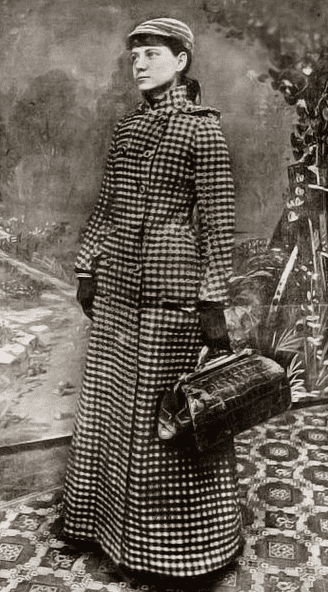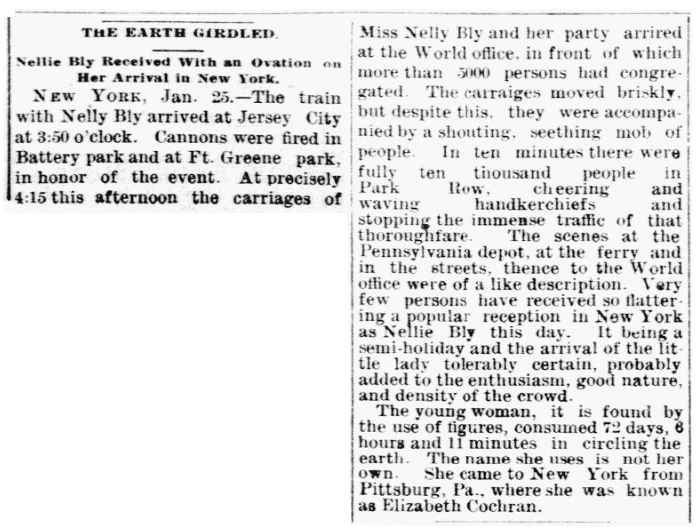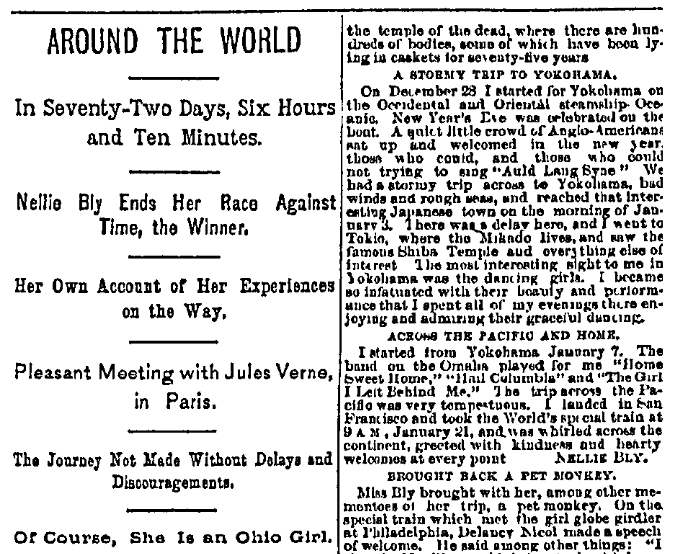Nellie Bly, a daring young woman reporter from Joseph Pulitzer’s New York World newspaper, arrived safely in New York City on 25 January1890, having set a new record by traveling around the world in 72 days. Her feat is little remembered today, but in 1889-90 her race against another woman, Elizabeth Bisland of Cosmopolitan magazine, was big news.

[Note: Nellie Bly was her pen name; her actual name was Elizabeth Cochran Seaman.]
Newspapers covered the race starting the day it began, 14 November 1889, and coverage only increased as they neared the finish line. Their goal was not only to beat each other, but also to best Jules Verne’s fictional record set by his hero in the 1873 novel Around the World in Eighty Days.
As the following accounts show, Bly won the race and triumphantly arrived in New York to the cheering acclaim of a large crowd. Bisland had the misfortune to arrive four days later – and almost no one noticed.

Here is a transcription of this article:
THE EARTH GIRDLED.
Nellie Bly Received with an Ovation on Her Arrival in New York.
NEW YORK, Jan. 25. – The train with Nellie Bly arrived at Jersey City at 3:50 o’clock. Cannons were fired in Battery park and at Ft. Greene park, in honor of the event. At precisely 4:15 this afternoon the carriages of Miss Nelly Bly and her party arrived at the World office, in front of which more than 5000 persons had congregated. The carriages moved briskly, but despite this, they were accompanied by a shouting, seething mob of people. In ten minutes there were fully ten thousand people in Park Row, cheering and waving handkerchiefs and stopping the immense traffic of that thoroughfare. The scenes at the Pennsylvania depot, at the ferry and in the streets, thence to the World office were of a like description. Very few persons have received so flattering a popular reception in New York as Nellie Bly this day. It being a semi-holiday and the arrival of the little lady tolerably certain, probably added to the enthusiasm, good nature, and density of the crowd.
The young woman, it is found by the use of figures, consumed 72 days, 6 hours and 11 minutes in circling the earth. The name she uses is not her own. She came to New York from Pittsburg, Pa., where she was known as Elizabeth Cochran.

Here is a transcription of this article, including passages written by Bly herself:
AROUND THE WORLD
In Seventy-Two Days, Six Hours and Ten Minutes.
Nellie Bly Ends Her Race Against Time, the Winner.
Her Own Account of Her Experiences on the Way.
Pleasant Meeting with Jules Verne, in Paris.
The Journey Not Made Without Delays and Discouragements.
Of Course, She Is an Ohio Girl.
NEW YORK, Jan. 25. – (Special.) – Nellie Bly has circled the world in seventy-two days, six hours and ten minutes. She arrived here to-day, flushed with triumph and in perfect health. The wear and tear of galloping about the globe has not told on her, and the plucky young woman seems to have been improved by her journey rather than to have suffered from it. Miss Bly, instead of resting after her long trip, has written a many-columned account of her spin about the sphere, which will appear in this morning’s World. Among other things she says:
“M. Jules Verne said it could not be done. I have done it. It was only sixty-eight days from the time I left American soil until I touched it again. During that time I was in many different climes. But only here, in God’s own country, have I passed amid fruits and flowers in valley and over mountain tops amid snow and frost, all within the space of sixteen hours. In no country save America is the passage from orange groves to snow-crested mountains possible in the same space of time.
“At many junctures since my departure have I been compelled to face what looked like failure. Did I ever give up hope of success? No, not exactly. I have already told the story of my trip across the Atlantic. We had a rough trip. And many bets were made on the boat as to whether I would arrive in Southampton to catch the India mail. I took all that were offered me.
Southampton to London.
“At 2:30 Friday morning, November 22, we anchored off Southampton, and by my own usual good luck I caught a special mail train from London. I stepped into an English coach. I must say that they leave much to be desired. I found what looked to be a long piece of iron, but which I learned was a foot-warmer. They think this is comfortable traveling in England. My feet burned through the thin soles of my shoes while I froze about my shoulders. In the morning they told me it was daylight or I would not have known it. I have a recollection of dim lights, a gray, dirty shadow overhanging the city and some fine buildings and people beginning to hurry when I reached London. We went to the Victoria street station. The trip to Amiens [France] was slow and tiresome, but I was fully repaid for the journey by meeting
M. Jules Verne and His Wife,
“Who were waiting for me at the station. As Mme. Verne spoke no English and I spoke no French our conversation was limited to smiles and cordial pressures of the hand, which I considered extremely kind and friendly. M. Verne wanted to know all about the trip. ‘If you make it in seventy-nine days I will applaud with both hands,’ he cried, and wished me ‘Good luck.’” After describing her visit to Jules Verne Miss Bly goes on to tell of her trip across Europe:
Nearly Missed the Steamer.
Nothing remarkable occurred until she reached Brindisi [Italy]. There she nearly missed her steamer. Indeed, Miss Bly had to run for it. Speaking of this event she says, “A porter took me by the hand, and, without further words, we tore madly through the dark streets and along the water’s edge. A whistle blew – all power seemed to leave me. We stopped in the middle of the street and looked blankly and hopelessly into each other’s faces. ‘My boat,’ I gasped, while my heart ceased beating. And again we started in a mad race which brought us by a sudden curve, breathless, at the foot of the plank. I uttered a prayer of thanks when I saw the Victoria still there. The boat bound for Bombay was gone, but I was saved. I went aboard and started the next day.
Brindisi to Portland.
“Everybody who sat on deck was wrapped up as were the two or three couples who walked leisurely around, but to me, who had slipped from seven days of freezing on the Atlantic and two days of chilling in France and Italy, it seemed as balmy as the days we dream about but never realize. There was a good deal of curiosity on board as to who and what I was, and what my object was in traveling alone. In a few days someone told me confidentially that it was passed around on board that I was an eccentric American heiress traveling about with a hair brush and a bank-book.
A Proposal of Marriage.
“The men on board were very attentive on account of my wealth. One young man, whose father boasted of a title, but who is a second son, asked me if I would marry him, and asked me also what I would do with him if I did. I told him I would put him to work, which had rather a dampening effect.
Through the Suez Canal.
“Port Said [Egypt] was our first stop, November 27. It is at the entrance to the Suez Canal, and while the boat was coaling all the passengers went on shore. The most amusing thing on shore are the burros, on which the passengers are generally very anxious to ride. The men who own these animals call out their attractions in English much after this style: ‘Do take a ride; here’s Mary Anderson, she’s got two beautiful black eyes; here’s Gladstone, he’s got two beautiful black eyes.’ The Suez Canal looks like nothing else than a mammoth ditch, the sand being dug out and thrown to either side. It took us twenty-four hours to pass through the canal, the boat being allowed to travel at the rate of only six miles an hour, because a rapid rate of speed washes down the high banks.
At Aden.
“Our next port was Aden [present-day Yemen], and a most beautiful place it is. At a distance it looks like one huge stone mountain, and when we got there it was not much else. Before we anchored the famous swimmers and divers were about the boat. The black people are perfectly bare except for small [sashes] about the waist, and their ability to swim and dive is something marvelous. While waiting for us to throw them money they actually sat in the water apparently without any effort to keep an upright position. They range in age from rather old men to boys of probably eight years. The water about here is filled with sharks but the people are never harmed by them. They say (I don’t know how true it is) dast (shark) will not eat a colored man, so that the natives are safe. We had to wait five days here for a connecting boat. The idea was not pleasant, but I utilized this time in seeing the beauties of Colombo.
Aden to Hong Kong.
“The Oriental, the boat in which I traveled from this point to China, was very commodious and the officers most agreeable. During the voyage from Singapore to Hong Kong we had the startling monsoon against us, but the Oriental, which was making its first trip to China and was trying to make a record, fought it bravely and reached Hong Kong two days ahead of my itinerary, December 23. Christmas day I spent in Canton, China, eating my lunch in the temple of the dead, where there are hundreds of bodies, some of which have been lying in caskets for seventy-five years.
A Stormy Trip to Yokohama.
“On December 28 I started for Yokohama on the Occidental and Oriental steamship Oceanic. New Year’s Eve was celebrated on the boat. A quiet little crowd of Anglo-Americans sat up and welcomed in the new year, those who could, and those who could not trying to sing ‘Auld Lang Syne.’ We had a stormy trip across to Yokohama, bad winds and rough seas, and reached that interesting Japanese town on the morning of January 3. There was a delay here, and I went to Tokio, where the Mikado lives, and saw the famous Shiba Temple and everything else of interest. The most interesting sight to me in Yokohama was the dancing girls. I became so infatuated with their beauty and performance that I spent all of my evenings there enjoying and admiring their graceful dancing.
Across the Pacific and Home.
“I started from Yokohama January 7. The band on the Omaha played for me ‘Home Sweet Home,’ ‘Hail Columbia,’ and ‘The Girl I Left behind Me.’ The trip across the Pacific was very tempestuous. I landed in San Francisco and took the World’s special train at 9 A.M., January 21, and was whirled across the continent, greeted with kindness and hearty welcomes at every point.” –Nellie Bly
Brought Back a Pet Monkey.
Miss Bly brought with her, among other mementoes of her trip, a pet monkey. On the special train which met the girl globe girdler at Philadelphia, Delancy Nicol made a speech of welcome. He said among other things: “I thought Miss Bly would bring back with her a husband. She has brought a monkey. Some husbands can be made monkeys of, but a monkey can never be made a husband.” Miss Bly is thoroughly content with the monkey and her glory, and says that she did not go hunting around the globe for a husband.
Reception in New York.
Miss Bly arrived in Jersey City this afternoon. There was a large crowd to greet her. Arriving in New York, she was driven to the World office, where Miss Bly received the congratulations of the editorial and reportorial staffs. A collation at the Astor House followed. Miss Bly has made the circumterrestrial journey in much shorter time than it has ever been made before, and hence her voyage has a certain scientific and mercantile interest.
Note: An online collection of newspapers, such as GenealogyBank’s Historical Newspaper Archives, is not only a great way to learn about the lives of your ancestors – the old newspaper articles also help you understand American history and the times your ancestors lived in, and the news they talked about and read in their local papers.
Related Article:
